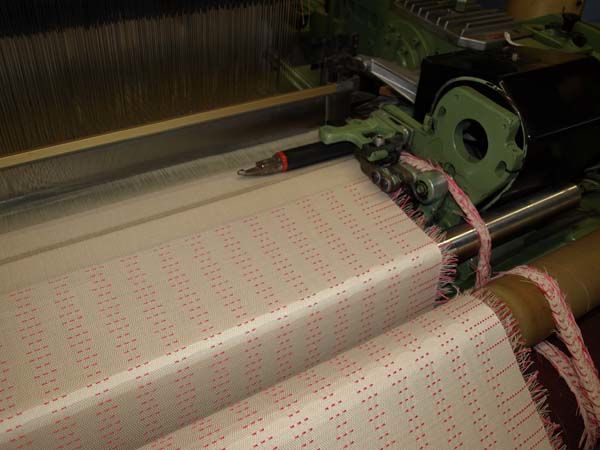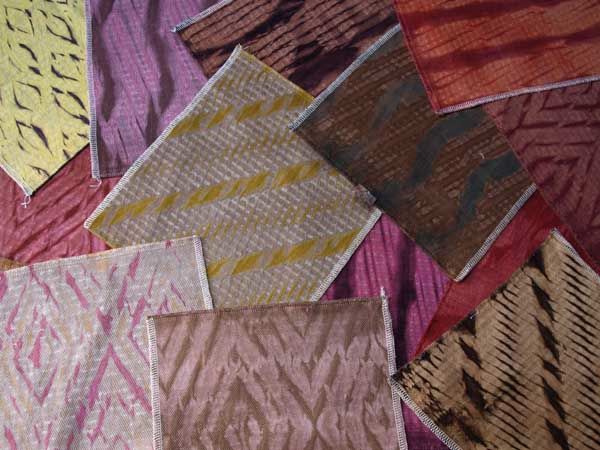Creative Collaboration: Woven Shibori + Mordants & Natural Dye Extracts
September 29, 2010
Origins of the Collaborative Experiment
In “Pearls from France and Other Places” (SDA Newsletter (printed) Summer 2009), Shop Talk columnist Jay Rich shared information about Michel Garcia‘s mordant block printing methods from the 2008 International Shibori Symposium. As  was mentioned in the article, Catharine Ellis also attended the symposium.
was mentioned in the article, Catharine Ellis also attended the symposium.
We, Donna Brown and Diane de Souza, noted the article with interest–but were uncertain as to how it might apply to our work utilizing natural dye extracts. When Catharine Ellis was scheduled to teach in our area in the Fall of 2009, we jumped at the chance to learn more about Garcia’s methods.
Ellis brought her cotton shibori fabrics (woven at The Oriole Mill in Hendersonville, NC) to use for our research and experimentation. These cotton fabrics, used in the samples described and pictured in this report, are woven from a high quality pima cotton which provides a beautiful sheen and is receptive to natural dye extracts. Designed by Ellis, they are woven with a ground structure (satin, twill, crepe, basket weave) as well as a separate shibori pattern which is pulled to create a resist.
Mordanting
Mordanting is a step done prior to natural dyeing using a chemical that aids in the binding of  dyestuff to fibers. For mordanting cotton, we had been using an immersion method with 5% WOG (weight of goods) aluminum acetate. Garcia created an aluminum acetate mordant for block printing by mixing potassium aluminum sulfate and calcium acetate. Ellis adapted Garcia’s recipe by making a 5% solution of aluminum acetate. As our cellulose mordant methods were different; we decided that prior to dyeing the fabrics we should compare the aluminum acetate immersion method to the adapted recipe from Michel Garcia1 which includes a fixing bath.
dyestuff to fibers. For mordanting cotton, we had been using an immersion method with 5% WOG (weight of goods) aluminum acetate. Garcia created an aluminum acetate mordant for block printing by mixing potassium aluminum sulfate and calcium acetate. Ellis adapted Garcia’s recipe by making a 5% solution of aluminum acetate. As our cellulose mordant methods were different; we decided that prior to dyeing the fabrics we should compare the aluminum acetate immersion method to the adapted recipe from Michel Garcia1 which includes a fixing bath.
 A more detailed explanation of the mordant experiments and results can be found in the Spring 2010 issue of the Turkey Red Journal: ( www.turkeyredjournal.com ). Our conclusion was that Ellis’s method, referred to as aluminum acetate mordant recipe, provided superior results. The fabrics were mordanted with this method.
A more detailed explanation of the mordant experiments and results can be found in the Spring 2010 issue of the Turkey Red Journal: ( www.turkeyredjournal.com ). Our conclusion was that Ellis’s method, referred to as aluminum acetate mordant recipe, provided superior results. The fabrics were mordanted with this method.
The order of the mordant and dye application steps varies the end results.
These are some of the processes we tried:
1) Pull the shibori threads to create a resist. Mordant the fabric. Immersion dye the fabric. Rinse and dry. Remove the shibori threads. Immersion dye in a second color.
2) Mordant the fabric. Immersion dye the fabric. Rinse and dry. Pull the shibori threads. Immersion dye in a second color.
3) Pull the shibori threads. Mordant the fabric. Paint each side of the fabric a different color. Steam to set. Remove the shibori threads. Immersion dye in a third color.
Water: Both rain water and city water  were used for the dye baths. All fabrics were thoroughly rinsed after the final dye step.
were used for the dye baths. All fabrics were thoroughly rinsed after the final dye step.
An alternative approach is to pull the shibori threads first and then apply the mordant with a brush as opposed to dipping the fabric in the mordant bath. This approach lends itself to including modifiers such as iron or acids at the same time. Large pieces of fabric are more easily mordanted and dyed with this method.
The resulting fabrics are shown throughout this article.
 Our conclusions:
Our conclusions:
It is possible to get intense colors on cellulose with natural dye extracts and the aluminum acetate mordant recipe with the specific fiber and fabric. As you would expect, some dyes are more effective than others. In subsequent experiments, we determined that aging or curing increases the effectiveness of this mordant method. The results have not been tested for light fastness.
Prepping the Fabric for Mordanting
The following steps are performed prior to all mordant methods:
1. Preparation of fabric for mordanting:
- Finish fabrics to avoid raveling.
- Label fabric with fabric type and indicate right and wrong side.
2. Scour the fabric:
Some fabrics just require wetting out; the Oriole Mill fabrics are an example. Most fabrics require a thorough scouring; even those sold as PFD (prepared for dyeing) as there may still be waxes, pectins, and oils that need to be removed before dyeing.
- Scour in hot to boiling water adding, at a minimum, a surfactant
- Some fabrics will require a cotton scour (1% based on the WOG) and soda ash (6% WOG) or washing soda
- Continue to scour until water is clear
3. Wet out the fabric with heat and a surfactant. Spin off or squeeze out excess water.
- Surfactants: Synthrapol, Joy detergent, Dawn detergent
Mordant Recipes for Cellulose fibers (using an aluminum acetate solution)
- Create an aluminum acetate mordant by mixing 50 grams aluminum sulfate and 50 grams calcium acetate in 2 liters of water (or equivalent).
2 Aluminum acetate mordant recipe (adapted from Garcia by Catharine Ellis, Diane de Souza and Donna Brown)
- Make a 5% aluminum acetate solution.
(For example: Dissolve 10 grams aluminum acetate in 200 ml of water.)
USE CAUTION when weighing aluminum acetate, which is a very fine powder.
USE GLOVES & MASK.
Mordanting Process
NOTE: Once you have prepared the aluminum acetate solution the procedure is the same for both methods
- Dip fabric in aluminum acetate (AA) solution (the solution can be at room temperature) for a few minutes (heavy fabrics need to stay longer) or apply aluminum acetate mordant to fabric with brush
- Dry the fabric completely with heat. A clothes dryer, hair dryer, or a drying box will work
- The dried fabric can be dyed immediately — although curing for at least a week is recommended for better results.
In preparation for dyeing, fix the mordant by soaking the dry, mordanted fabric in chalk/corn starch solution.
- Mix 28 g of chalk, 4 liters of water, and 4-5 grams of corn starch
- Heat solution to 160 F Note: the cornstarch needs heat to dissolve
- Note: the chalk solution can be kept and reused
- Rinse fabric briefly in water.
The fabric is ready for immersion dyeing.
Alternatively, fabric may be painted with dye (dye can be thickened) and steamed to set.
Suppliers and contacts for additional information:
Fabrics for shibori from The Oriole Mill: Catharine Ellis, catharine@ellistextiles.com.
Dye supplies sourced from: Table Rock Llamas Fiber Arts Studio: www.tablerockllamas.com
__________________________________
Donna Brown is a fiber artist with degrees in Textile Chemistry and Clothing & Textiles. In addition to teaching courses on natural dyeing using extracts, she is natural dye sales representative and ongoing natural dye instructor for Table Rock Llamas Fiber Arts Studio in Black Forest, Colorado. She loves to share her knowledge and passion for natural dyes via courses she has conducted at Penland School of Craft, John C. Campbell Folk School and at fiber festivals, the 2003 SDA conference and the 2002 Color Congress. An SDA member, she also sews, hand-spins and weaves.
Diane de Souza‘s extensive background in fiber and weave structures comes from her experience working with everything from weft face rug weaving to 24-shaft loom controlled work. She has been actively weaving for 10+ years and knitting, crocheting, (among other processes) for many more. Her current focus is “interesting” fibers, dyeing with natural dye extracts, loom controlled shibori and complex loom controlled weave structures. She posts irregularly on her blog dyeing2weave.wordpress.com
Catharine Ellis taught the Professional Craft Fiber Program at Haywood Community College for 30 years and is now devoted to studio work, travel and conducting workshops. She continues to explore new applications of woven shibori including Jacquard and industrial production. Catharine has taught and exhibited internationally. She is the author of Woven Shibori (Interweave Press, 2005) and her work has been featured in Fiberarts Magazine, Surface Design Journal and other publications. For more information visit: www.ellistextiles.com
Catharine Ellis will be teaching a workshop at CONFLUENCE: 2011 International Surface Design Association Conference in June, 2011, co-sponsored by Textile Center Minneapolis. It is titled: Woven Shibori, Natural Dyes on Cotton, No Loom Required. Conference brochures will be mailed in October 2010 and complete information will soon be available on the conference page of the SDA website surfacedesign.org







1 Comment
Astrid Bennett says
October 1, 2010 at 11:15 am
Interesting article! Pictures! When I was an undergraduate at Indiana University in the 1970s, I became keenly interested in printing etchings on fabric after learning that it had been done in France in the 1800s. I learned then that it was about steel engravings working with mordant printing, so obviously, there's a lot to be learned out there. All the more interesting to learn that it's with natural dyes!
Related Blog Articles
Creative Process
“Fringe: On the Edge of Fiber” — Out Now!
Creative Process
Friday Fibers Roundup: Craft & Color
Creative Process
“Standing Tall: A Heart-FELT Reflection” by Martien van Zuilen